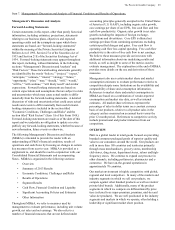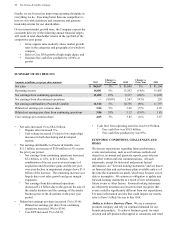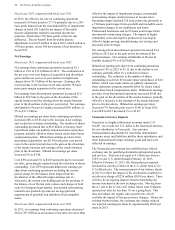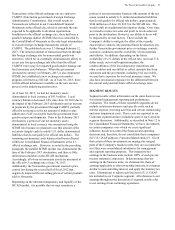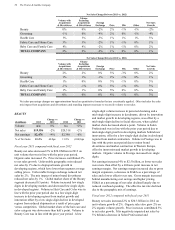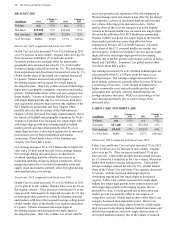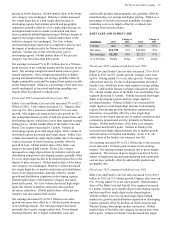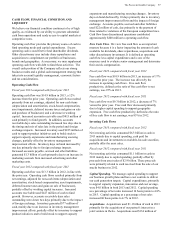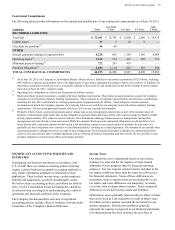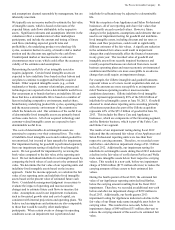Proctor and Gamble 2013 Annual Report Download - page 33
Download and view the complete annual report
Please find page 33 of the 2013 Proctor and Gamble annual report below. You can navigate through the pages in the report by either clicking on the pages listed below, or by using the keyword search tool below to find specific information within the annual report.The Procter & Gamble Company 31
Transactions at the official exchange rate are subject to
CADIVI (Venezuelan government's Foreign Exchange
Administrative Commission). Our overall results in
Venezuela are reflected in our Consolidated Financial
Statements at the official rate, which is currently the rate
expected to be applicable to dividend repatriations.
In addition to the official exchange rate, there had been a
parallel exchange market (SITME) that was controlled by
the Central Bank of Venezuela as the only legal intermediary
to execute foreign exchange transactions outside of
CADIVI. The published rate was 5.3 through February 12,
2013. The notional amount of transactions that ran through
this foreign exchange rate for nonessential goods was
restrictive, which for us essentially eliminated our ability to
access any foreign exchange rate other than the official
CADIVI rate to pay for imported goods and/or manage our
local monetary asset balances. When the government
devalued its currency in February, 2013, it also eliminated
SITME, but established a new exchange rate market
program, referred to as SICAD. As of June 30, 2013, there
is little official information available on the new auction
process or the underlying auction rates.
As of June 30, 2013, we had net monetary assets
denominated in local currency of $913 million. Local
currency balances decreased 14% since June 30, 2012 due to
the impact of the February 2013 devaluation and an increase
in payments by the government through CADIVI, partially
offset by an increase in the net amount of indirect value
added taxes (VAT) receivable from the government from
goods receipts and shipments. Prior to the February 2013
devaluation, a portion of our net monetary assets
denominated in local currency was remeasured using the
SITME rate because we planned to use that amount of the
net assets (largely cash) to satisfy U.S. dollar denominated
liabilities that do not qualify for official rate dollars. The
remaining net monetary asset balances had been reflected
within our Consolidated Financial Statements at the 4.3
official exchange rate. However, as noted in the preceding
paragraph, the parallel SITME market was eliminated at the
time of the February 2013 devaluation, and there is little
information available on the SICAD mechanism.
Accordingly, all of our net monetary assets are measured at
the official 6.3 exchange rate at June 30, 2013.
Additionally, the Venezuelan government enacted a price
control law during the second half of fiscal 2012 that
negatively impacted the net selling prices of certain products
sold in Venezuela.
Depending on the ultimate transparency and liquidity of the
SICAD market, it is possible that we may remeasure a
portion of our net monetary balances (the amount of the net
assets needed to satisfy U.S. dollar denominated liabilities
that do not qualify for official rate dollars, approximately
$240 million as of June 30, 2013) at the SICAD rate. This
would result in an additional devaluation charge. Over time,
we intend to restore net sales and profit to levels achieved
prior to the devaluation. However, our ability to do so will
be impacted by several factors. These include the
Company's ability to mitigate the effect of the recently
enacted price controls, any potential future devaluation, any
further Venezuelan government price or exchange controls,
economic conditions and the availability of raw materials
and utilities. In addition, depending on the future
availability of U.S. dollars at the official rate, our local U.S.
dollar needs, our overall repatriation plans, the
creditworthiness of the local depository institutions and
other creditors and our ability to collect amounts due from
customers and the government, including VAT receivable,
we may have exposure for our local monetary assets. We
also have devaluation exposure for the differential between
the current and potential future official exchange rates.
SEGMENT RESULTS
Segment results reflect information on the same basis we use
for internal management reporting and performance
evaluation. The results of these reportable segments do not
include certain non-business unit specific costs such as
interest expense, investing activities and certain restructuring
and asset impairment costs. These costs are reported in our
Corporate segment and are included as part of our Corporate
segment discussion. Additionally, as described in Note 12 to
the Consolidated Financial Statements, we have investments
in certain companies over which we exert significant
influence, but do not control the financial and operating
decisions and, therefore, do not consolidate these companies
for U.S. GAAP purposes ("unconsolidated entities"). Given
that certain of these investments are managed as integral
parts of the Company's business units, they are accounted for
as if they were consolidated subsidiaries for management
and segment reporting purposes. This means pre-tax
earnings in the business units include 100% of each pre-tax
income statement component. In determining after-tax
earnings in the business units, we eliminate the share of
earnings applicable to other ownership interests, in a manner
similar to noncontrolling interest, and apply the statutory tax
rates. Eliminations to adjust each line item to U.S. GAAP
are included in our Corporate segment. All references to net
earnings throughout the discussion of segment results refer
to net earnings from continuing operations.




